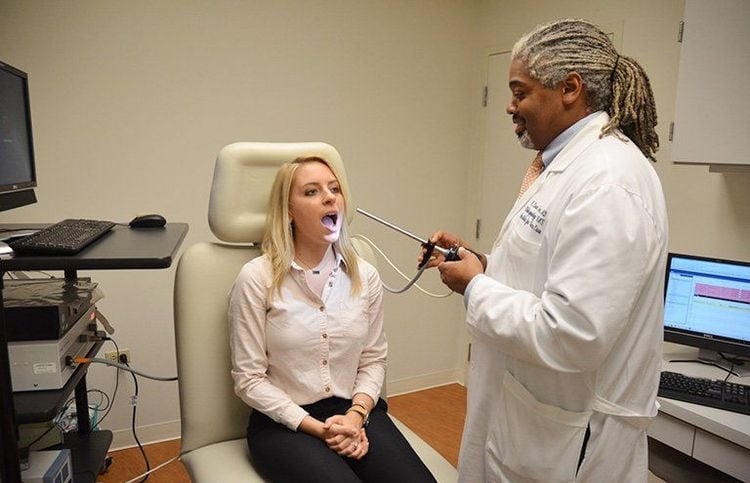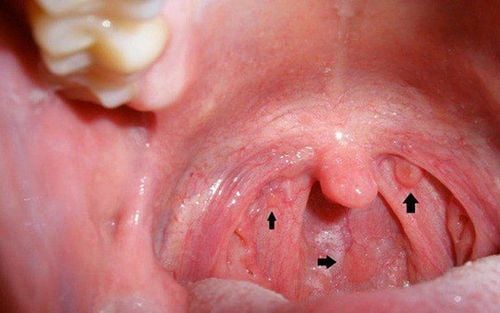This is an automatically translated article.
Laryngeal cancer is a fairly common cancer today, accounting for 2% of all common cancers. Prognosis of laryngeal cancer is often better than that of other cancers if diagnosed and treated promptly.
1. An overview of laryngeal cancer
The larynx is a part of the respiratory system, located between the lower pharynx (bottom of the tongue) and the esophagus/trachea. The larynx is structured like a triangular prism, in the upper hole of the tube there is a protective cap to prevent food and drink from falling into the lungs. In the lower 1⁄4 of the larynx, there is a narrowing created by the two side bands, this is a movable part that closes during vocalization and opens when the person breathes. The functional larynx helps to guide air in and out of the lungs, helping to protect the respiratory tract by creating a cough and choking reflex when a foreign object falls into the larynx to expel the foreign object. Another important function of the larynx is to help with speech, when damaged vocal cords can cause hoarseness or loss of voice.
Laryngeal cancer is a tumor located in the lumen of the larynx, mainly carcinoma, and very rare cancer of the larynx. Laryngeal cancer is a fairly common type of cancer today. Within the ENT region, laryngeal cancer ranks fourth after nasopharyngeal cancer, sinus cancer and hypopharyngeal cancer. According to statistics in many countries around the world, laryngeal cancer accounts for 2% of all common cancers.

Thuốc lá làm tăng nguy cơ mắc bệnh ung thư thanh quản
The main cause of the disease has not been clarified so far, but many studies have shown that the important factors that contribute to the development of laryngeal cancer are tobacco, alcohol; occupational factors such as working in hazardous environments, exposure to chemicals, mine dust with chrome, nickel; people with a history of radiation therapy in the neck area, people with gastroesophageal reflux disease, ... The rate of men with the disease is much higher than that of women due to less exposure to risk factors for the disease. .
Prognosis of laryngeal cancer is very heavy in the late stage, so early detection plays a very important role. Symptoms of laryngeal cancer are voice disturbances such as hoarse, hard, prolonged and increasing voice; sore throat or a feeling of throat tightness, prolonged cough, difficulty breathing, ... Patients should soon go to medical facilities for examination if they have the above symptoms.
2. Classification of laryngeal cancer
Laryngeal cancer originates from the larynx, consisting of the following layers: the inferior surface of the epiglottis, the laryngeal band, the larynx of Morgagni, the vocal cords and the subglottis or in the border of the larynx. Depending on the location and extent of the tumor, laryngeal cancer can be classified as follows:
2.1. Epiglottitis cancer
This type of laryngeal cancer usually arises at the same time in both the laryngeal band and the inferior surface of the larynx. In the early stages, the image of laryngeal cancer is difficult to evaluate because the laryngeal base and vocal cords are normal. At this time, a CT scan is required to evaluate the depth of the cancer infiltration.
If laryngeal cancer originates from the larynx of Morgagni, it is usually proliferative or ulcerative, and the cancer spreads rapidly to adjacent areas such as above the larynx, below the vocal cords and subglottis, and beyond the thyroid cartilage. ... This type of laryngeal cancer accounts for 8-10% of laryngeal cancers. Symptoms often appear late, when the patient has hoarseness symptoms, the tumor has spread into the vocal cord mucosa and funnel cartilage.

Khàn tiếng là triệu chứng thường gặp của bệnh ung thư thượng thanh môn
2.2. Vaginal cancer
This is the most common type of laryngeal cancer. The most common is proliferative carcinoma, rarely infiltrative or ulcerative. Symptoms of voice disorders such as hoarseness, fatigue, and cough appear early. If you seek medical attention at the onset of symptoms, the lesion is usually limited to the superior surface or free margin of the vocal cords.
Because the submucosal connective tissue of the vocal cords is often dense and the lymphatic membrane is tender, vocal cord cancer usually progresses slowly over months, sometimes even years. Carcinoma of the vocal cords is usually localized on one side for a long time before spreading to the opposite vocal cords.
The signs in the late stage are coughing up mucus and blood, discomfort in the throat, pain in the neck, feeling like there is a foreign body, difficulty breathing in the larynx, pain may spread to the ear. The picture of laryngeal cancer in the late stage of the vocal cords is a widespread tumor that covers the lumen of the larynx, causing swallowing disorders; When the tumor spreads beyond the larynx to the lower throat, it will cause swallowing difficulties, choking, swallowing obstruction.
2.3. Subglottic cancer
This is a less common type of laryngeal cancer than the two above. Cancer is usually an infiltrating form below the vocal cords, spreading and deep below the mucosa, blocked by the thyroid cartilage, so it is difficult to spread. Because the free margin of the vocal cords is still normal, it is difficult to visualize laryngeal cancer on indirect bronchoscopy. In order to obtain accurate lesions, direct laryngoscopy is required, sometimes even thyroid cartilage is opened to obtain a sample of the lesion for testing.
Prognosis of laryngeal cancer in the glottis, if not timely intervention, the cancer grows rapidly to the opposite side, crosses the anterior edge of the larynx and then spreads below the cricoid cartilage. U can also spread above and behind the cricoid fissure joint, causing the vocal cords to become immobilized.

Ung thư hạ thanh môn được chỉ định nội soi thanh quản nhằm lấy được chính xác thương tổn
3. Diagnosis and prognosis of laryngeal cancer
If detected early, timely surgery, patients can recover good pronunciation, the rate of disease can be completely cured up to 80%. Symptoms of laryngeal cancer often appear early, patients go to the doctor early, so the detection rate is high. As for the types of cancer of the upper glottis and cancer of the pharynx, due to its discreet symptoms, patients are often ignored and often go to the doctor when the disease is at a late stage.
To detect the disease, in addition to the clinical examination, look and feel the anterior larynx, thyroid cartilage, laryngoscopy, full body examination,... The doctor will appoint paraclinical tests to help confirm the diagnosis. include:
Magnetic resonance imaging (MRI) Tilting neck film Taking tomo larynx CT Scanner detecting opacity, spread of tumor Neck ultrasound Biopsy of tumor tissue to diagnose pathology, do lymphadenopathy cytological identification. If left untreated, the prognosis for laryngeal cancer is quite poor, with patients usually only living a year or 18 months. Patients died from acute asphyxiation, complications of bronchopneumonia, physical exhaustion or massive bleeding.

Chụp MRI giúp chẩn đoán tình trạng bệnh ung thư thanh quản
4. How is laryngeal cancer treated?
The principle of laryngeal cancer treatment is a combination of surgical, radiotherapy, chemotherapy and immunotherapy methods. The success of treatment depends on the stage of the tumor. Treatment at an early stage, the doctor will surgically cut the vocal cords, the patient can still preserve the voice. If it is at a late stage, the doctor must remove the larynx partially or completely in combination with surgery to remove the cervical lymph nodes. After surgery, the patient will receive postoperative radiation therapy and combination chemotherapy. To help patients recover their voice after laryngectomy, the doctor may perform laryngotracheal valve implantation, esophageal voice training, or use an electric laryngoscope.To prevent the risk of laryngeal cancer, quitting smoking is an extremely important measure. Studies show that 12% of people with laryngeal cancer smoke cigarettes compared to 2% of non-smokers. In addition, it is necessary to thoroughly treat gastroesophageal reflux disease to avoid causing inflammation of the oropharynx, limit alcohol, stimulants such as coffee, carbonated soft drinks, etc. In particular, it is necessary to go Early examination when symptoms of hoarseness persist, use of drugs to treat laryngitis does not help, symptoms of shortness of breath appear.

Khách hàng có thể thực hiện Tầm soát, và phát hiện sớm ung thư vòm họng, hạ họng, thanh quản tại Bệnh viện Đa khoa Quốc tế Vinmec
If not treated early, patients with laryngeal cancer often have a short survival time. Patients can die due to acute asphyxia, exhaustion, complications of bronchopneumonia or massive bleeding,... Therefore, a prerequisite in fighting the disease is effective prevention by quitting smoking. Leaves, limit alcohol consumption, definitively treat related diseases, raise awareness of the importance of screening for oropharyngeal cancer as well as periodic health check-ups.
Currently Vinmec International General Hospital is implementing a package of screening and early detection of oropharyngeal, hypopharyngeal and laryngeal cancers including:
Full range of necessary services for early detection of oropharyngeal cancer showing other abnormalities in the arch - hypopharynx - larynx area When registering for the screening package, and early detection of nasopharyngeal, hypopharyngeal, laryngeal cancer, customers will be screened for nasopharyngeal - hypopharyngeal cancer - larynx through general otolaryngology examination with hard or soft endoscope; Software ultrasound, thereby detecting the disease early, improving the effectiveness of treatment, increasing the survival rate for patients.
Please dial HOTLINE for more information or register for an appointment HERE. Download MyVinmec app to make appointments faster and to manage your bookings easily.













